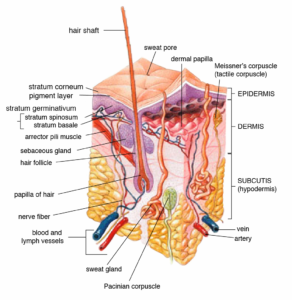Probably the most researched areas of Light Therapy (Photobiomodulation) is Red Light Therapy. The picture below shows where on the spectrum of visible light (to the human eye) red light’s range is.

Red Light is known to have a penetration depth of 8-10mm. Looking at the ruler below, that doesn’t seem like it goes that far into the body.

However, when you look at a cross section of the skin, you can see Red Light penetrates into the the lowest layer, the subcutaneous layer.

As you can see on the right side of the cross section, there are three layers to our skin. The epidermis, dermis, and the subcutaneous (subcutis) or hypodermis layer.
What’s special about the subcutaneous (hypodermis) layer? It houses nerves, blood & lymph vessels, sweat glands, and the sebaceous gland which regulates the oil for your skin, to name a few.
Another key aspect to the subcutaneous layer is the amount of fat cells it contains. Those cells are important to insulate the body and regulate body temperature. Think about an elderly individual who is often cold, more easily bruised, etc. With age, people have more potential to loose the fatty cells of the subcutaneous layer.
That’s where Red Light Therapy comes into play. We know that Red Light increases nitric oxide (NO), which dilates the blood vessels, allowing for more and better circulation. With better circulation, the body is able to produce more collagen, stimulate lymphatic vessels, promote wound healing, assist with burns, and much more more. Red Light Therapy, through increased circulation, allows the body to begin its natural process of healing.
If you found this blog interesting check out Photonic Therapy Institute for upcoming classes and our free weekly Office Hours webinars where we welcome anyone who would like to learn more about Light Therapy & Photopuncture.
























